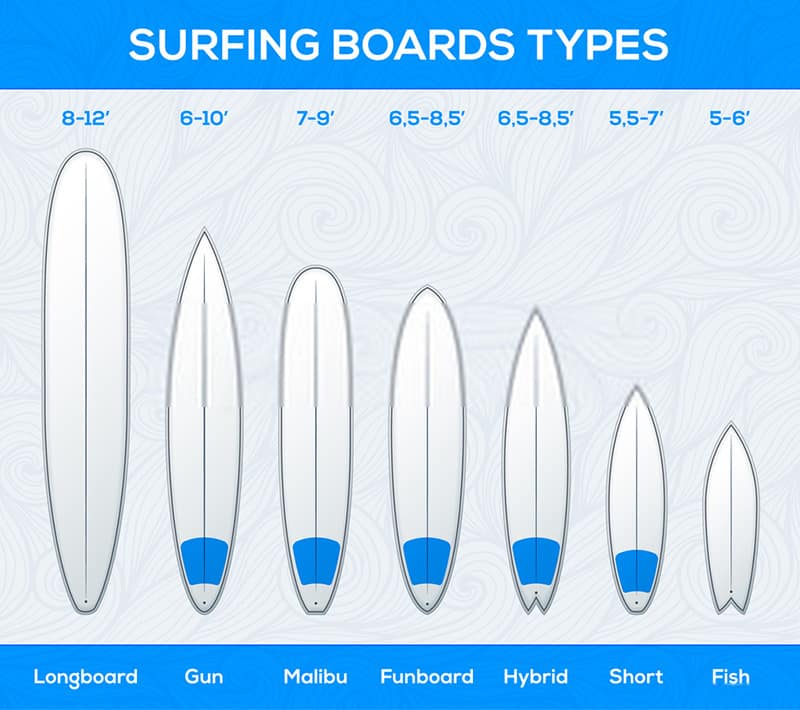Choosing a suitable surfboard size is the most important step and, simultaneously, the most difficult for any surfer. The right surfboard size will help you enjoy the waves while a wrong one will frustrate and even injure you.
Regardless of your experience level, surfboard size matters and it’s even more important if you are a beginner. As a newbie, it is perfectly normal if you don’t know how to choose a surfboard size for beginners.
When making your choice, there are important things to consider. This article will comprehensively explain everything you need to know as regards choosing the best surfboard for beginners.
Table of Contents
Choosing the Right Surfboard Size as a Beginner
As a beginner, you probably haven’t tried surfing. If any little experience all, you must have done that using a rented or borrowed surfboard. Understandably, that’s quite uncomfortable.
Obviously, you are training and hoping to become a professional or expert wave rider someday. You want an easy-to-ride surfboard that you can help you catch waves easily. At the same time, you want to improve your balance and stability whilst riding.
All these can be enjoyed if it’s the right size for you and your experience level. Below are the important factors to consider on how to choose a surfboard size for beginners.
See Also: 19 Tips for Beginner Surfers
1. Types of Surfboard
Although not too important, the types of surfboards available can determine the size you should go for. There are three popular types of surfboard based on construction – fiberglass and epoxy boards.
Fiberglass boards are the commonest but suitable for experts. The epoxy surfboards are durable, rugged, easy-to-control, and lighter, hence, a good choice for beginners. Whatever your choice, just make sure you get a good surf wax for it.
2. Wave Type and Location
Wave type (and location) also matters a lot. Ideally, you should start with small waves. Nevertheless, your location may not offer you such an option.
If your location has slower, gentler waves, longer boards will be best for you. It will allow you to capture more waves for training. In steeper waves, heavy waves, you should go for smaller ones.
3. The Volume of the Surfboard
Before you can pick the best surfboard for you, you need to find out the volume of the surfboard. The volume of a surfboard is described as the total area occupied by a surfboard and measured in liters.
The volume of a surfboard is crucial because it influences buoyancy, control, balance, speed, and the entire performance of the board. In a nutshell, it affects your entire surfing experience.
A surfboard’s volume is calculated with its width, length, and thickness. In some cases, the volume of the surfboard is written on it or contained on the website of the manufacturer. It is often written in this format – 6’5” x 21” x 3” – 45.9 liters.
As a beginner, you can only train and enjoy surfing if you are well balanced on your surfboard. You want a surfboard that can offer balance, control, and, maybe, speed. Hence, there are two types of surfboard based on volume – low volume and high volume.
Low volume boards are often smaller than what you need, very sensitive to waves, easy to maneuver, and fast. However, they are less stable and won’t work well for you (beginners) as they require more experience.
In your case, you should consider the high volume since the advantages are more favorable towards your experience level. High volume boards are easy to ride, offer great balance, and can help you catch waves effortlessly.
However, they are less maneuverable and may not allow any tricks, at least, you get to learn the basics easily. As a beginner, you should be riding on surfboards with volumes equivalent to your weight in kilograms i.e. 70kg person to a 70-liter surfboard.
4. The Length of the Surfboard
Most first-timers often have issues with the length of the surfboard to go for. So which length is ideal for beginners, a long or short one? The length is measured from the nose to the tail and calculated in feet.
The length of a surfboard has a direct influence on the performance of the surfboard. Therefore, there are benefits associated with both long and short surfboards.
The shorter surfboards offer great performance in small waves as they are lighter and, easy to maneuver and control. Since they have smaller areas, they are best for performing tricks whilst exhibiting greater speeds but they are less stable.
On the other hand, longer surfboards are more forgiving. They cover a larger surface area which implies larger stability even against large waves. The deck is spacious enough to accommodate all your awkward postures.
They are best for catching waves regardless of the size of the waves but they are less maneuverable. One other disadvantage is their portability as they require surfboard racks for cars instead of surfboard travel bags.
As a beginner, the longer surfboards are the best options to go for. However, the length of your surfboard should be relative to your height.
Below is a simple table to help you determine which surfboard length works for you. The recommendation is derived from height and weight, however, your weight is a more important criterion. If you are heavier than the range, just go for something longer.
| Surfer’s Height | Surfer’s Weight (lbs.) | Recommended Board Length |
| 5’ and less | < 120 | 6’8” – 7’2” |
| 5’1” – 5’4” | 120 – 140 | 7’2” – 7’6” |
| 5’5” – 5’8” | 140 -165 | 8’ – 8’6” |
| 5’9” – 6’1” | 165 – 190 | 8’6” – 9’2” |
| 6’2 – 6’4” | 190 – 210 | 9’2” – 9’6” |
| 6’ and more | 210 > | 9’6” > |
5. Width of the Surfboard
From one edge to the other edge of the surfboard along its width at the widest point is the width of your surfboard. Most times the widest point is often at the center or close by. Nevertheless, you can find it on the packaging or manufacturer’s website.
Narrow boards are ideal for advanced surfers since the surface area is small and stability is lower. The advantage is in the maneuverability and its flexibility for tricks.
For you as a beginner, you should be targeting something wider. The wider the board, the higher the stability and balance which is definitely what you want from your board.
But there will be more drag, resulting in less speed. Who wants speed or perform tricks when they have not mastered balancing on their surfboard?
6. The Thickness of the Surfboard
Surfboards come with varying thicknesses and this property contributes to the overall performance of the board. Thicknesses often influence the degree of maneuverability and control.
For thinner boards, a high degree of experience is required. Thin surfboards allow you to dig the rails easily to make quick and sharp turns and even more carving.
Thicker boards are very robust with a more rigid feeling on your feet. They catch waves pretty easily and move at high speeds, although these are relative to the length and width.
Beginners should consider going for thicker boards. If you are heavier, you should go for thicker surfboards.
7. Your Fitness Level and Frequency of Surfing Sessions
Your fitness level should be put into consideration too. If you are not very fit or you are just in for recreation, a high volume surfboard will be the best for you. You will be able to catch waves more easily.
If you won’t be surfing daily, the high volume boards are ideal. Regular practice brings perfection. You don’t want to be struggling with a small surfboard.
Frequently Asked Questions (FAQs)
It’s possible that you’ve skipped some cogent points in the article or you’ve come here seeking answers. Therefore, I’ve compiled some frequently asked questions to help clear your mind.
What size surfboard should a beginner use?
Beginners should consider settling for bigger surfboards. As a beginner, you are obviously going to have issues with balancing and stability. Bigger boards provide more stability, buoyancy, and enough space to accommodate your awkward moves and stands.
How tall should your surfboard be?
Ideally, you should have a board that is longer than your height. I recommend going for boards that are about 3 feet more than your height. For more accuracy, you should follow my chart above.
WindSurfingMag Overview
One thing is to find a quality surfboard, another is to find the most suitable surfboard size. Even if you have a quality surfboard, if it doesn’t match your need, it will frustrate you.
As a beginner, you should be more concerned about picking the right surfboard size. While an intermediate or advanced rider may be able to ride, you will find it extremely difficult to train.
For this reason, you need just some little useful knowledge to help you enjoy your surfing. You need to know how to choose a surfboard size for beginners. This article is made comprehensive to help you address the situation.
Do you have any questions, suggestions, or comments? Please share them with other readers in the comments section.
Help your friends know how to choose a surfboard size for beginners by sharing this article with them on Twitter, Facebook, and other social media platforms.

